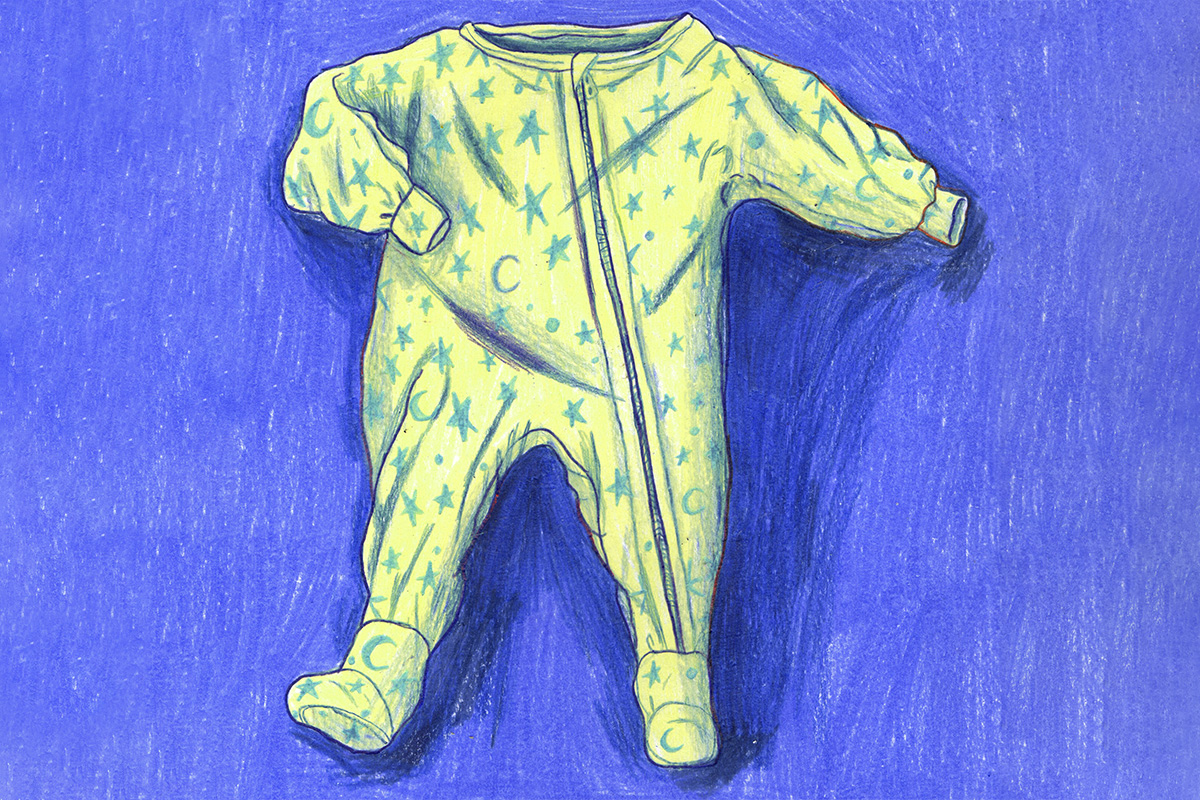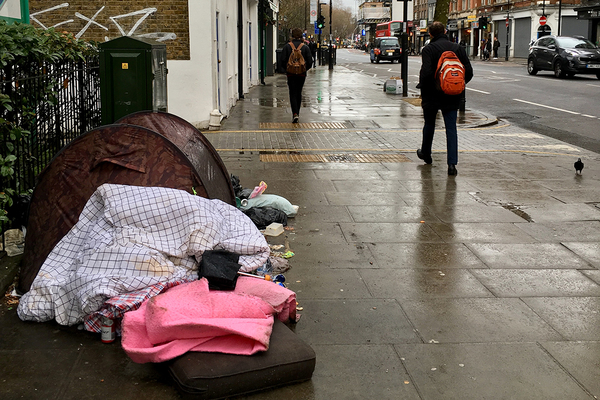You are viewing 1 of your 1 free articles
Rough sleeping: on the frontline with an outreach team
James Riding spends a morning in south London shadowing Lambeth’s rough sleeping outreach team, to find out how councils are tackling homelessness

It is 6.30am on a dark, wet morning near London’s Waterloo Station. I’m following seven members of Lambeth Council’s rough sleeping outreach team, McDonald’s coffees in hand, as we patrol along the South Bank, past the National Theatre and into the tunnels around the IMAX cinema.
Charity Thames Reach has run this team on behalf of the London borough since 2020, and it is clear how well the team knows the streets and the people sleeping here. Before we even leave the station, Chantelle Gardner, Thames Reach’s project manager, strikes up a conversation with a rough sleeper in a psychedelic jacket. He had been drifting in and out of sleep and apologises for being confused, but was happy to comply with Ms Gardner as she explained she was from the Lambeth outreach team and took his personal details.
With levels of homelessness at their highest in nearly 20 years, soaring costs of temporary accommodation threatening to bankrupt local authorities and ranks of tents pitched on the capital’s busiest streets, how are leaders across the country adapting their support offering? And how has it changed life on the frontline?
Ms Gardner follows the same script as all her Thames Reach colleagues: she takes some basic details, asks him if he wants any help, then checks his name on a database called Chain (Combined Homelessness and Information Network) on her phone. If he has a history, his profile is updated; if not, a new profile is created.
In this instance, the rough sleeper did not want to be helped, but he will still go on the database. Rough sleepers do not have to give permission to be entered on Chain. However, outreach workers must provide them with a leaflet that outlines all their rights regarding GDPR and their access to their data on the system.
Over time, the team will try and talk to him again and find out what support he is eligible for. Housing is the long-term goal, but with 40,000 people on the council’s waiting list, more immediate help is critical.
Randy Asante, rough sleeping co-ordinator at Lambeth Council, explains: if it is someone’s first night sleeping rough, they can stay in one of three nearby halls funded by the London mayor’s No Second Night Out scheme; if they have a clear connection to the borough, they can sleep on a camp bed in the Lambeth Assessment Centre for a couple of days. If not, more checks. Can they access welfare or benefits? What is their immigration status? Do they have complex needs? In a matter of minutes, a pathway is decided.
In the 1980s, Waterloo’s concrete tunnels were home to Cardboard City, a shanty town of elaborate encampments built from wooden pallets, which housed around 200 residents at its peak. Today we see around 13 rough sleepers in total. Although it has changed a lot from the Cardboard City days, the problem is far from gone. In 2022-23, 623 rough sleepers were recorded in Lambeth, up 40% in two years. A further 4,000 households live in temporary accommodation, including 5,000 children.
We stop at St John’s Church, where Thames Reach lead worker Joe Clowsley has been working with two rough sleepers. Mr Clowsley knows many of the people we come across by name. By regularly patrolling the same patch, he can form a long-term rapport with entrenched rough sleepers, which is crucial when it comes to persuading them to take up a hostel place. However, given the area’s proximity to the train station, around 40% of his encounters are with people just passing through. “I’ll meet someone from Woking and never meet them again,” he says.
As we walk through the drizzle, I ask Ms Gardner, who has managed homelessness services in the area for eight years, what has changed over this time. The demography of rough sleepers is different since the pandemic and the onset of the cost of living crisis, she says. “We’re seeing a lot more stable people rough sleeping” (people who had a tenancy until they lost their job, or were kicked out of the family home), rather than “typical, entrenched’’ rough sleepers. This brings new challenges. It is “very hard to resettle people who are working”, she says. A lot of landlords offering housing through the Single Homeless Project prefer to take in people on benefits, because it offers guaranteed income.
“We want people to be independent,” she says, but the system almost disincentivises people from trying to find work and “get their life back together”.
Lambeth is housing newly homeless private renters in the Belvedere Hotel in Clapham South. The government’s Rough Sleeping Initiative has provided funding for 25 hotel rooms that the outreach team can book for people who have been sleeping rough (another 15 are booked out for people who qualify for temporary accommodation). The council has also commissioned the Single Homeless Project to liaise between landlords and private renters to prevent tenancy breakdown.
There is another new demographic on the streets: asylum seekers who have been forced to leave Home Office accommodation. Since August, newly recognised refugees have been given just seven days to leave the accommodation they were living in while their claims were being processed. “They’re the younger group, the under 35s,” Ms Gardner says.
The number of refugees presenting as homeless after eviction from Home Office accommodation in the capital increased by 39% in October, to 846 people, according to the cross-party group London Councils, with the number likely to rise in the coming months as ministers seek to clear the asylum backlog.

Just three years ago, the government’s Everyone In initiative secured temporary accommodation for nearly 15,000 rough sleepers in two months at the onset of the pandemic.
Mr Asante says Lambeth struggles to house people with immigration issues because the law states that they have no recourse to public funds. For these people, a 13-bed night shelter is available for stays of between three months and a year, while the council works with the Southwark Law Centre to resolve immigration issues.
Faith-based organisations like Missionaries of Charity can also house them, he adds.
The council currently houses around 12 long-term rough sleepers via the central government-funded Housing First scheme and is bidding for more support.
Council homelessness services are under pressure. Glasgow has experienced £21m of cuts to health and social care services, including homelessness, while the 2023-24 Northern Ireland budget proposes a £7.4m cut in homelessness funding. At least three English local authorities are proposing to decommission homelessness services in the coming months, as they come under increasing financial pressure.
Spiralling costs
The amount Lambeth spent on hotels for people at risk of homelessness increased fivefold in the past four years, from £240,226 in 2019-20 to £1.3m last year. According to London Councils, boroughs are set to overspend their budgets by £600m this year, primarily due to rising demand for temporary accommodation.
Maria Kay, Lambeth’s cabinet member for better homes and reducing homelessness, says there are “very real challenges with ongoing cuts to the public sector, followed by the cost of living crisis”, which are reflected in the “steep rise we have seen in the number of rough sleepers in our borough”.
Ms Kay blames this on the “erosion of social housing under Right to Buy, the government’s failure to replace those homes and big increases in the costs of renting”.
Across the country, councils are responding to rising homelessness in different ways. Jim Crawshaw, head of housing at Coventry City Council, says he is seeing “more and more people coming through the door for assistance”. The council is repurposing an older people’s accommodation scheme and buying up 50 former student houses to turn back into family homes for temporary accommodation.
“Now there’s a lot more purpose-built student accommodation in the city centre,” he says. Bringing these homes “back into family use is a priority for us”.
£240,226
Amount Lambeth spent on hotels in 2019-20
£1.3m
Amount Lambeth spent on hotels in 2022
Southampton City Council has also experienced an increase in demand for homelessness services. “It’s the after-effects of COVID-19, it’s the cost of living, it’s pressures from people coming from outside the area, so they haven’t got family connections in the city,” says Matt Wilkin, its senior communications officer.
The council has commissioned a mediation service “so where relationships break down between landlords and tenants, we try and work through those issues”, and encourages members of the public to support rough sleepers “responsibly” by tapping their cards on contactless giving points that send the money to local charities, he says.
For the past three years, Greenwich in London has worked with crowdfunding company Beam to support 120 people out of temporary accommodation and into the private rented sector. The council refers people to Beam, which sets them up with a case worker and a crowdfunding page. Unlike sites such as JustGiving, Beam splits its donations across multiple recipients in the donor’s local area to avoid competition between recipients.
Jamie Carswell, director of housing and safer communities at the Royal Borough of Greenwich, says the scheme has saved the council money on temporary accommodation and they “haven’t had many returners”. Private companies can provide innovative solutions, he says. “Would a local authority have come up with Beam? Probably not.”
The Thames Reach team and I emerge from the tunnels as the sun is coming up. In a covered area outside St Thomas’ Hospital, the team spots a tent. “We don’t zip tents open,” Ms Gardner says. Instead, Mr Clowsley and colleague Sarah Longwill crouch down and announce themselves as members of the Lambeth outreach team. It emerges that the person inside has been offered a hostel place, but declined it – a “common thing”, she says.
A colleague, Keith, will visit three times a day to “put the pressure on” them to take up their bed space. If they do not accept in seven days, they will have to start the referral process again.
Ms Longwill says the most common reason people do not want to go into hostels is that they do not want to be around drug or alcohol users. Others may have mental health issues or have had negative experiences that mean they distrust homelessness services.
Two weeks after our shift, then-home secretary Suella Braverman called rough sleeping a “lifestyle choice” and threatened action against charities that help people sleeping rough.
As I witnessed, some people decline a hostel bed. But people do not want this life.
Ms Braverman’s words demonstrate what Ms Longwill sees as the biggest challenge: educating people about the legal and factual realities of rough sleeping, the benefits system and anti-social behaviour. The Thames Reach team emphasises the danger and isolation faced by those they support. As Mr Asante says: “When you’re sleeping on the street, it’s a dark world.”
Sign up for the IH long read bulletin
Already have an account? Click here to manage your newsletters












